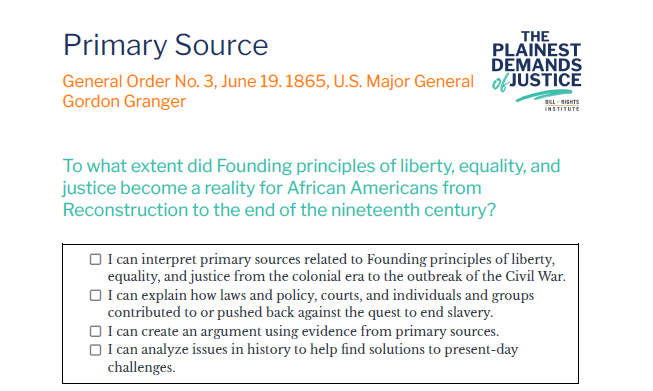General Order No. 3, June 19. 1865, U.S. Major General Gordon Granger
Guiding Question: To what extent did Founding principles of liberty, equality, and justice become a reality for African Americans from Reconstruction to the end of the nineteenth century?
- I can interpret primary sources related to Founding principles of liberty, equality, and justice from the colonial era to the outbreak of the Civil War.
- I can explain how laws and policy, courts, and individuals and groups contributed to or pushed back against the quest to end slavery.
- I can create an argument using evidence from primary sources.
- I can analyze issues in history to help find solutions to present-day challenges.
Building Context
On January 1, 1863, President Abraham Lincoln issued the Emancipation Proclamation in the midst of the Civil War. The Proclamation declared “that all persons held as slaves” within the rebellious states “are, and henceforward shall be free.” Roughly two and a half years later, the Emancipation Proclamation finally took effect for the enslaved community in Texas with General Order No. 3. Despite the end of the Civil War in April 1865, Texas slaveholders had not freed their slaves. The arrival of General Granger and his army represented the federal government’s final execution and fulfillment of the terms of the Emancipation Proclamation. This event is celebrated as Juneteenth and is the oldest known celebration commemorating the end of slavery in the United States.
General Order No. 3, June 19. 1865, U.S. Major General Gordon Granger
Source link: https://catalog.archives.gov/id/182778372
The people of Texas are informed that, in accordance with a proclamation from the Executive of the United States, all slaves are free. This involves an absolute equality of personal rights and rights of property between former masters and slaves, and the connection heretofore existing between them becomes that between employer and hired labor. The freedmen are advised to remain quietly at their present homes and work for wages. They are informed that they will not be allowed to collect at military posts and that they will not be supported in idleness either there or elsewhere.
Comprehension and Analysis Questions
- How does General Order No. 3 fully execute the Emancipation Proclamation of 1863? What does the more than 2-year gap reveal about the complexity of ending slavery?
- What does this order suggest freedmen should do in their new position? Why might this suggestion lead to future problems between freedmen and landowners?
